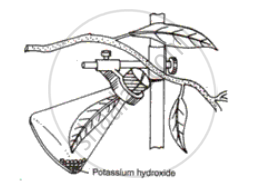Advertisements
Advertisements
प्रश्न
An experiment was set up as shown in the figure given below . The twig in the diagram was intact on the plant and it was as such in sunlight for a few hours .

(i) What is the aim of the above experiment ?
(ii) Why was potassium hydroxide placed inside the conical flask ?
(iii) What test would you perform on the leaf inside the flask?
(iv) What is the expected result of the above test ?
(v) Is it necessary to similarly test on outer leaf also ? Giva a reason .
उत्तर
(i) The aim of the experiment is to prove that CO2 is necessary for photosynthesis.
(ii) Potassium hydroxide absorbs CO2 from the surrounding. It is placed to remove CO2 within the conical flask.
(iii) The leaf inside the conical flask would be tested for the presence of starch by the application of iodine.
(iv) The expected result of the above test is - No change in the colour will be observed.
(v) Yes, it is necessary to similarly test on the outer leaf also to show that leaves present in CO2 show photosynthesis.
APPEARS IN
संबंधित प्रश्न
Name the following:
The main mineral constituent of chlorophyll.
Are the following statement true or false? Give a reason in support of your answer.
Destarching of the leaves of a potted plant can occur only at night.
Given below is the representation of a certain phenomenon in nature. With four organisms 1-4.

Name any one organism that could be shown at No .5
Given alongside is the diagram of an experimental set-up:

Will it work satisfactorily? Given reason.
A potted plant was taken in order to prove a factor necessary for photosynthesis. The potted plant was kept in the dark for 24 hours. One of the leaves was covered with black paper in the centre. The potted plant was then placed in sunlight for a few hours.
Write a balanced chemical equation to represent the process of photosynthesis.
ATP is needed for the dark reaction.
Differentiate Between:
Light reaction and Dark reaction.
Name the following:
The site of light reaction in the cell of a leaf.
Give technical term:
Name only one plant, you are familiar with which has no chlorophyll.
